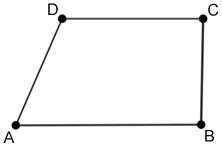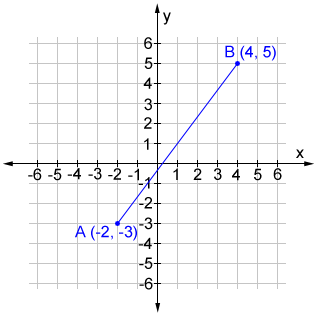Endpoint
In geometry, an endpoint is a point at the end of a line segment or ray.
Naming objects using endpoints
Many objects in geometry such as line segments, angles, polygons, etc., can be named using endpoints:
Points A and B are endpoints for the line segment below. The line segment is named by its endpoints, or .

A ray on the other hand, has only one endpoint as shown below. The ray is named using its endpoint as the first letter, .

An angle can be named using the common endpoint of the two rays, as shown below. Rays and share endpoint B and form an angle. This angle can be named as ∠ABC or, using just its endpoint, as ∠B.

A polygon is formed by three or more-line segments. The polygon below, called a quadrilateral, is formed by segments AB, BC, CD, and AD, called sides. Each side intersects two other sides, at each endpoint. One way to name a polygon involves listing the endpoints of the polygon in sequence; the polygon below can be named ABCD or BCDA, among other names.

Length of a line segment and endpoints
In coordinate geometry, the endpoints of a line segment can be used to determine the length of the segment using the equation:
Where (x1, y1) and (x2, y2) are the coordinates of the two endpoints.
Example:

Find the length of if the coordinates of the endpoints, A and B, are (-2, -3) and (4, 5), respectively.
| length = | |
| = | |
| = | |
| = | 10 |
So, the length of is 10.
